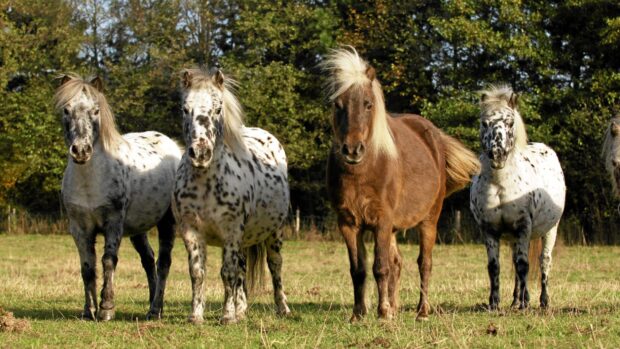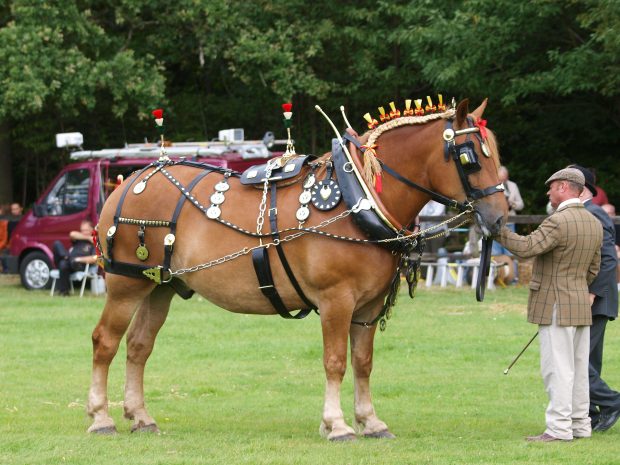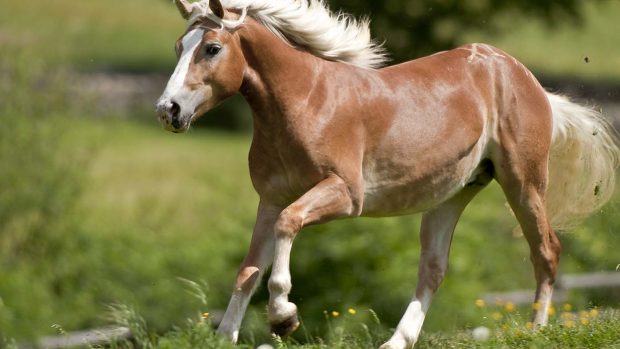The Akhal-Teke is an elegant, exotic horse, which exudes grace and athleticism. This ancient breed started out in the hot climates of the central Asian desert as a ridden horse for the Turkmen people, and as such it is known for its tremendous stamina, soundness and speed. They are a national symbol in Turkmenistan, where they celebrate a national holiday in April ever year in honour of the breed, and appear as the centrepiece in their state emblem.
Their glistening coat is another notable characteristic, which typically has a metallic shimmer, leading to their nickname “golden horses”.
With records dating back three millennia, the Akhal-Teke is thought to be one of the world’s oldest breeds, but is now considered rare due to an estimated global population of fewer than 5,000 – however this is likely to be a conservative estimate. The breed is listed as “threatened” by the Livestock Conservancy. They are predominantly found in Russia and Turkmenistan.
In this article: Looks and conformation | Golden coats | Temperament | Movement and Uses | History | Cost
Looks and conformation
- Overall impression: lithe athleticism without excessive musculature. Should show extreme stamina and hardiness
- Head: long and narrow, with a flexible poll and long, slim, forward-set ears. Large nostrils, think lips and hooded or “oriental” eyes
- Neck: long and slim, set high out of the shoulder; refined throatlatch
- Front: high withers with sloping and free-moving shoulders. Narrow chest when viewed from front, but deep girth
- Back: general impression of length but without frailty, with a long, strong back and level topline.
- Hind end: wide hip angle giving appearance of strength, with low-set tail
- Limbs: the breed typically has dense bone and small, hard hooves, giving these horses the ability to pound hard surfaces. Large joints, short cannons, flat knees, low-set hocks, long and smoothly muscled forearm and gaskin. Clean and well-defined tendons. Pasterns should be long and of an identical angle to the hoof and shoulder. No feathers
- Size: 14.3hh to 16hh – average 15.2hh
- Colour: any colour is acceptable, with any combination of white markings. Metallic gleam is a desirable feature
‘Golden’ coats
The Akhal-Teke’s glimmering, shiny coat is one of the breed’s hallmarks. Whatever the coat’s colour, there is a metallic sheen, which is particularly significant in those with buckskin colouring as it makes the horse appear golden. This sheen is due to a unique hair structure which bends sunlight through one side of the hair and refracts it out the other side, creating the golden glow. This colouring is also thought to have originally provided camouflage in the desert.
Their coat is designed to enable these horses to withstand both heat and cold – as found in their initial desert habitat. Their mane and forelock are sparse, their skin is thin and the coat is short and silky. In winter, they grow a dense undercoat to provide warmth.
The Akhal-Teke is most commonly bay, buckskin, black, chestnut, grey, cream or palomino. However, cremello and perlino are also present, albeit more rarely. Blue eyes, one blue eye or marbled eyes are fairly common.
Temperament
Like the Arab horse and thoroughbred, Akhal-Tekes are hot-blooded. They may be energetic and spirited, although like any horse much of their temperament may be down to how they are handled. They are naturally sensitive but compliant. They have been bred selectively over thousands of years to cooperate with man, being tethered outside their riders’ tents, and as such they are sometimes likened to dogs in their devotion to their master.
Some experts believe that – unlike most breeds – they bond closely with one master during their lifetime, and maybe protective over that owner.
Movement and uses
Due to their ability to carry a rider over long distances, the Akhal-Teke’s gaits are characterised by a wide step and flat trot and canter, making for a comfortable ride. They typically have a unique trot that gives a smooth ride over long distances. Instead of the two-beat trot with diagonal pairs seen in most breeds, the Akhal-Teke steps down with each foot individually.
In Russia, they are used as racehorses at distances over 1km–6km. They are said to be faster than thoroughbreds over the longer distances.
They are specialist endurance horses. Groups of Akhal-Tekes have made a number of documented journeys as part of varied campaigns over the years, such as a 4,300km trek in 84 days from Ashkabad, Turkmenistan, to Moscow in Russia.
While they are fast, showing exceptional agility and speed over a range of distances, the Akhal-Teke is less well-known in the sport horse disciplines. However, there have been a number of jumpers, including the brilliant Penteli, who was in the USSR Olympic team. They have set puissance records in Russia, Asia and Eastern Europe, where the breed is prevalent, but they have not proved as popular in the west.
The most famous Akhal-Teke sport horse was another USSR contender, Absent, who won individual gold at the Rome Olympics in 1960, individual and team bronze in Tokyo in 1964, and team silver in Mexico City in 1968. Absent also sired grand prix dressage horses.
Akhal-Tekes are believed to have been used historically in the development of the thoroughbred and the Arabian. Nowadays, they are often crossed with warmbloods to produce sport horses.
Potted history
The precise origins of this ancient breed are hazy, but the Akhal-Teke developed in Central Asia, the country we now call Turkmenistan, some 3,000 years ago. They lived in the Karakum desert, which shaped the breed’s distinctive characteristics. The Turkmen people bred tough, fast and stamina-laden horses to suit their nomadic lifestyle, raiding against other tribes and surviving in the hot, dusty climate.
The name Akhal-Teke was first used in the 17th century. Akhal is the name of a line of oases in Turkmenistan, and also means pure, while Teke is from the eponymous tribe.
The Russians first acquired Akhal-Tekes some 500 years ago, and have been closely associated with preserving the breed since then, including establishing a stud farm when they annexed Turkmenistan in 1881.
How much does an Akhal-Teke cost?
As with any horse, there is no ballpark figure on how much an Akhal-Teke costs. Prices are dependent on age, pedigree, training, temperament, conformation, ability and so on. Because the Akhal-Teke is such an aesthetic horse, those with a a strong metallic sheen to their coats tend to command higher prices. You might imagine that the breed’s rarity would make them more likely to be comparatively expensive, however on sales sites they are listed at current market rates for horses of other breeds with similar experience.
You may also like to read…
Find out everything you need to know about this popular breed of horse

The Arabian horse: the history, hallmarks and heritage of this graceful breed

The athletic thoroughbred: everything you need to know

The original Black Beauty? All you need to know about the magnificent Friesian horse

Subscribe to Horse & Hound magazine today – and enjoy unlimited website access all year round
Horse & Hound magazine, out every Thursday, is packed with all the latest news and reports, as well as interviews, specials, nostalgia, vet and training advice. Find how you can enjoy the magazine delivered to your door every week, plus options to upgrade your subscription to access our online service that brings you breaking news and reports as well as other benefits.




